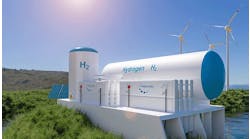Cooper Technology in New MTL Fieldbus Barrier Acquisition by Cooper Crouse-Hinds hasn’t blunted MTL’s appetite for innovation in its core intrinsic safety and fieldbus technologies. Quite the reverse, according to fieldbus products product manager Phil Saward. "They’ve been very supportive of new product introductions. Indeed, this new product draws heavily on technology which comes from Coopers."Saward was briefing INSIDER on MTL’s new range of Fieldbus Barrier wiring hubs for Foundation fieldbus which complement its recent innovations in FISCO (Fieldbus Intrinsically Safe Concept) technology including redundant FISCO. Whereas under FISCO, everything in the hazardous area has to be intrinsically safe (IS), the barrier technique allows the use of a non-IS ‘High Energy Trunk’ based on Increased Safety Exe techniques for the home run. The barrier itself is then located in the field and interfaces the individual IS spurs connecting field instruments and devices to the trunk. According to Saward, FISCO tends to be used more in applications where distances are relatively short, notably offshore, while the barrier approach, which has a slightly larger market share, is more popular in refineries and similar sites where cable runs are long or can still be unknown at the design or specification stage. Poor ImplementationFieldbus barriers have been around for at least 10 years, but Saward freely admits that neither MTL’s nor its competitors’ solutions have been particularly easy to work with. "Barriers have a lot of potential and a lot of advantages, but we have to admit that the implementation has been poor. We’re responding to what our customers have been telling us and fixing the things that were really difficult." To that end, rather than being hard-wired like its conventional predecessors, the new 9370-FB comprises interface modules plugging into a fixed carrier housed in a stainless steel or carbon-loaded GRP enclosure. The principal benefit of the new approach is the significant degree of live workability it allows. Traditionally, any work on a barrier would either require the whole installation to be powered down or a more complex arrangement with an increased potential for human error. In the 9370 FB, by contrast, barrier modules, terminators and optional surge protectors can all be removed and replaced in the hazardous area without having to power down the segment, thanks to innovative connector technology developed by Crouse-Hinds. "That’s a unique first," says Saward, who estimates that it reduces the time required for a typical maintenance activity and, hence, for maintenance personnel to have to remain in the hazardous area, from between 20 and 30 minutes to just two or three.FlexibilityIncreased modularity doesn’t just benefit the maintenance phase however. With details such as the number of instruments on each segment frequently not finalized until quite late in a project, the new approach offers the option, for example, to specify a 12-spur enclosure, but to fit it with only a single six-spur module, allowing for additional spurs to be accommodated if a change is made later in the project, or even during the subsequent life of the plant. In Saward’s words, it’s all about "Derisking the design phase."There’s a similar flexibility on surge protection. The new FS32 surge protection device (SPD), which can also be used to protect new or existing TL Megablock wiring hubs, can be added to a spur simply by unplugging the termination from the module and inserting the SPD without the need for any additional wiring. Again, just how many spurs may need protection may not be known until a late stage in the project. "You can plug it in at any point, even as an afterthought,” says Saward. “You can even add it when surge protection is required in response to a surge event, something you couldn’t do before."
Latest from Safety Instrumented Systems
Latest from Safety Instrumented Systems



